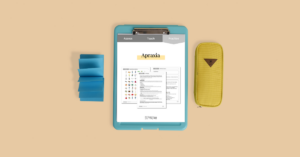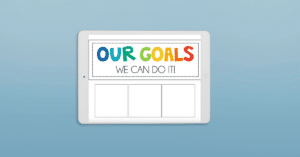Listen on Apple Podcasts Listen on Spotify
You set the goal, then what?
As SLPs, we implicitly “know” the importance of goal awareness, but it’s also something that’s really easy to take for granted. You set the goal, talk about it with the student, and then keep it in mind when you’re in session, right?
Here’s a question for you to think about:
After you set the goal, how do you keep it top of mind—for yourself, and your student?
Marisha shares her answer to that question in this week’s episode of the podcast, all about increasing goal awareness with your students.
There is so much research to support goal awareness promoting better outcomes in therapy, and it’s something Marisha has noticed in her own practice too!
When she makes a habit of reviewing and talking about students’ goals, she’s fascinated by the impact that goal awareness has on their session engagement and progress.
And — one of the best things about increasing goal awareness is that when parents and teachers ask what the students do in speech therapy, they don’t just say “we play games.” They’re actually able to share the goal and how they’re working on it! 😅
Three tips to help SLPs increase goal awareness:
1️⃣ Involve students in the goal-creation process
This may not work with every student on every caseload, but it can be so helpful in deciding on a goal to target, and getting students invested in their own progress. Keep it simple: Ask students what some of their long-term goals are, or what they struggle with throughout the school day, and go from there.
2️⃣ Make goal cards for (or with!) your students
I do this with almost all of my students! I either type up the goal card and print it out, or I have them write out the goal in their own words. Sometimes they draw a picture that represents the goal and why it’s important to them. Have fun with this! Click here to download a free goal card template!
3️⃣ Incorporate the goal cards into your speech routine
This may seem obvious, but once you’ve created the goal cards, make sure they get put to use! I like to keep the goal cards organized using anonymous stickers or symbols (to honor the students’ privacy!) so they know how to identify their packet and pick it up as part of their speech routine.
Marisha’s tips will help you enroll your students in the goal-setting process, and make a huge difference in the progress they’re making—especially if you review, review, review.
Learn more about how to make more goal-awareness magic happen in your speech sessions when you listen to this episode of the SLP Now podcast.
Resources + Links Mentioned:
Click here to download a free goal card template!
Calendar pocket chart on Amazon
Speech Room Organization: Student Goals
Subscribe
Subscribe to the SLP Now podcast and stay tuned for our next series. We’re kicking off September by helping you get your data collection, paperwork, and therapy planning processes in tip-top shape! 💪
Listen to The SLP Now Podcast on Apple ★ Spotify ★ Google ★ Stitcher ★ Castbox or wherever you listen to podcasts.
Transcript
Marisha:
Hello there, and welcome to the SLP Now Podcast, where we share practical therapy tips and ideas for busy speech language pathologists. Grab your favorite beverage and sit back as we dive into this week's episode.
Hey there, and welcome back to the SLP Now Podcast. Today we get to chat about some strategies to increase student goal awareness, and we are going to dive into three tips to make that happen. And just a little bit of context as to why we might even want to chat about this. I think we implicitly know the importance of goal awareness, but I just wanted to share a quick experience that I've had with incorporating this with my caseload.
So, it's really fascinating to see the impact that targeting goal awareness can have on students' engagement and progress. And there's a lot of research to support this. We won't go into all of those details in this podcast. I'm just sharing a little bit of personal experience just in the difference that I've seen. And one of my favorite impacts of targeting goal awareness is that when teachers or parents ask students, "What do you do in speech therapy?" Instead of saying, "We play games." They're actually able to say what we work on, which is the best feeling ever when I see that happening. So, let's go ahead and dive into the three tips.
So, tip number one is to involve students in the goal creation process, and of course, this will vary depending on the details of a particular caseload, and it might not work with every single student. If we can involve them as much as possible, I think that can have a really meaningful impact. And just even just asking them what feels hard during the school day or what's important to them. So, even with my younger students, I would ask them what they wanted to be when they grow up, and we always get some interesting answers, especially in the younger grades. A lot of kids say they want to be YouTubers. One of my students said that he wanted to be a dad. And so, I was able to acknowledge and hear and celebrate the goals that they have for themselves, and then tie their goals to how that would help them with that in the future.
So, that's tip number one. Involve students in the goal creation process as much as possible. And asking students what their longer term goals are is a great easy way to start. And then, even asking them what they struggle with throughout the school day or as you're going through the assessment process, asking them some questions and getting feedback on how they're perceiving different activities and whatnot.
And then that brings us to tip number two on how to actually increase that goal awareness from session to session. So, the strategy that I've come up with is to create goal cards. And again, this looks really different depending on the students that I'm working with. With almost all of my students, I'll make little goal cards, and sometimes I'll type out the goal and just print the cards with the goal written on it, or I will have the students write out the goal in their own words if that's appropriate. And/or I'll have them draw a picture to represent that goal and to represent what that goal means to them. And so, the goal cards are just literally little pieces of paper and they have a stack of cards depending on how many goals they have. And at the beginning of every session, we'll reference those goal cards.
Which brings us to tip number three, which is to incorporate those goal cards in your daily routine. So, what that looks like, and assuming that if the students are coming to the speech room, then I have a calendar pocket chart that I really like to use. And I have a template for the goal cards that fit into that calendar pocket chart. So, if you want to see my pocket chart, and if you want to download the template that I use, you can go to slpnow.com/164. Again, that's S-L-P-N-O-W.com/164. You can find the link to the pocket chart and the goal card template and also just see it for some inspiration.
So, I have the pocket chart with the students' goal cards, and I just put a colored piece of paper on top of the packet of goal cards, and then the students get to pick a sticker. Because I used to write the students' names on the front of their packet, but the other students were a little bit too curious about who was in speech, and I wanted to protect that confidentiality a little bit more. So, I decided to use anonymous stickers. And that was a really fun activity for students. They really liked getting to pick their sticker. Older students could draw a symbol if they wanted to, if stickers are a little bit too juvenile.
So, they would walk in, they'd immediately recognize their packet, and they would grab the set of goal cards and then go to the therapy table. If I was doing this in the classroom, I would just bring the goal cards with me, and that would be the first things that we do. And the students know to open up their packet and look through the cards and just review their goals. And like I said, it might have the goal typed out, written in the student's words, a picture. We might have a note about the why or why the goal is important, but they get to look at that visual representation at the beginning of every session and review their goals.
So, those are the three tips that I use to increase goal awareness in my sessions. So, one, involve students in the goal creation process. Two, create goal cards. And then three, incorporate those goal cards in your daily routine. And there's lots of fun things that we can do with the goal cards. We can have little challenges to see if they're able to memorize their goals and just list them off. And this gets really easy for students to do if we're constantly reviewing them. So, that can be a fun challenge to see who has their goals memorized by the end of the first quarter or semester or whatnot.
But yeah, those are the three tips to increase goal awareness. I hope this was helpful. I'd love to hear how you implement this or what this looks like in your speech room. And that's a wrap. We'll see you next time.
Thanks for listening to the SLP Now Podcast. If you enjoyed this episode, please share with your SLP friends and don't forget to subscribe to the podcast to get the latest episode sent directly to you. See you next time.
Sign up to receive email updates
Enter your name and email address below and I'll send you periodic updates about the podcast.




Reader Interactions